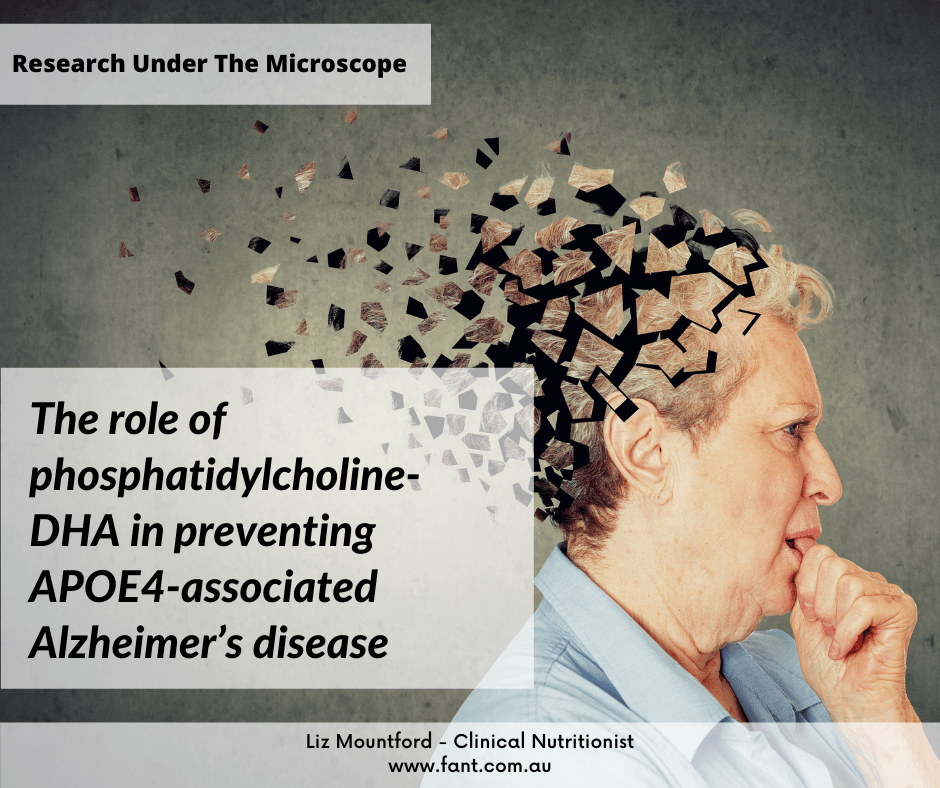Research Under The Microscope Series
The research evidence supporting the use of specific nutrition, diet and food interventions is getting larger all the time and translating new research is often difficult and time consuming. Also, certain research findings such as those from cell or animal studies have limitations when attempting to translate into human clinical practice and must be done with caution.
The aim of “Research Under The Microscope” series is to translate research papers that are quite often technically complicated, extremely lengthy and contain large amounts of data into simple everyday language making it quicker and easier to understand the research findings.
Alzheimer’s Diseases and the Role of Phosphatidylcholine-DHA
What is the problem and what is known so far?
Alzheimer’s disease (AD) is the most common progressive neurodegenerative disorder in Australia. Characteristics of AD is progressive memory loss, spatial disorientation, cognitive dysfunction, and behavioural changes.
Currently, there is no cure and treatments are usually based on managing symptoms.
Intakes of Ω-3 (omega-3) fatty acid docosahexaenoic acid (DHA) has been observed to reduce the risk of AD and ease the symptoms of cognitive decline.
Low levels of Ω-3 DHA fatty acid have been demonstrated to promote all 3 hallmarks of AD which include:
- Extracellular amyloid-b plaques.
- Intracellular neurofibrillary (tau) tangles.
- Reduced glucose uptake in the brain.
What is the background to this research?
The apolipoprotein E (APOE4) allele is to date the highest factor in determining the risk of AD. Previously it has been observed that sufferers of AD with the APOE4 single nucleotide polymorphisms (SNPs), respond more favourably to food sources Ω-3 DHA fatty acids as found natively in fish, rather than supplementary forms such as fish oil capsules.
What was studied in this research?
The researchers wanted to understand the mechanisms behind why sufferers of AD with the APOE4 single nucleotide polymorphisms (SNPs) respond better to the Ω-3 DHA fatty acids in dietary fish rather than fish oil tablets.
How was the research performed?
This research looked at all the current knowledge of AD and the cell changes seen in people with AD. The researchers reviewed how cell changes in people with AD might impact the metabolism of the different Ω-3 DHA fatty acids found in food sources vs supplement sources. In doing this, the researchers were able to propose a clear mechanism on why dietary fish is more effective than fish oils in AD sufferers with the APOE4 SNPs.
What did the study researchers find?
The researcher found that Ω-3 DHA fatty acids is packaged differently between food and most supplement forms. DHA in seafood sources metabolise to a phospholipid form known as DHA-lysoPC and is transported into the brain using a specific transporter, the MSFD2A which is found on the inner membrane of the endothelial cells that line blood vessels on the blood brain barrier (BBB).
Supplements predominantly metabolise to plasma free DHA and then passively diffuse between the BBB cells and into the brain via tight junctions. In APOE4 suffers with AD, the tight junctions are damaged disrupting the transport of free DHA into the brain.
What is the take home message?
- DHA is an essential Ω-3 fatty acid making up approximately 30% of the fat found in the human brain.
- In AD, Ω-3 DHA fatty acids have been observed to:
- Reduced amyloid-β plaques, aggregation and cellular toxicity.
- Promotes amyloid-β plaques clearance.
- Reduced tau tangles.
- Facilitates transport of glucose into the brain.
- 2 grams of DHA supplements for 6 months demonstrated a reduction in phosphorylated tau protein in cerebrospinal fluid.
- The major genetic risk factor for AD is in the form of a variant of the human apolipoprotein E (APOE) gene which impacts the metabolism of DHA fatty acids via several mechanisms including:
- Carriers of the APOE4 gene may have impaired brain transport of free DHA due to the break down in the outer membrane leaflet of the BBB.
- Impaired brain transport of free DHA may explain the greater therapeutic effect in consuming fish rather than fish oil tablets.
- Seafood sources of DHA is phospholipid form and appears in the plasma as DHA-lysoPC. This may impact how the Ω-3 DHA fatty acids is metabolised and transport into the brain.
Typical Levels of Ω-3 DHA fatty acids in common Australian Seafood:
| Fish Type | % of Ω-3 DHA Fatty Acids |
|
Deep Sea Cod |
47.1% |
|
John Dory |
45.1% |
|
Red Snapper |
43.3% |
|
Squid |
42.6% |
|
Flat Head |
41.5% |
|
Southern Bluefin Tuna |
29.3% |
|
Herring |
29.3% |
|
Prawn |
15.4% |
What You Can Do Now
Start to incorporate some of the foods suggested above into daily meals. Changes don’t need to happen all at once. Small changes can make an enormous difference.
Changes to your diet or nutrition to manage a health condition should only be undertaken with advice from a suitably qualified nutritional health professional.
This factsheet is for general information only.
Please contact me to discuss your individual needs.
Bibliography:
- Patrick RP. Role of phosphatidylcholine-DHA in preventing APOE4-associated Alzheimer’s disease. The FASEB Journal [Internet]. 2018 Oct 5 [cited 2018 Oct 31];fj.201801412R. Available from: https://www.fasebj.org/doi/abs/10.1096/fj.201801412R
- Soltan, Saharrobert S. A. M., and Robert A. Gibson. 2008. ‘Levels of Omega 3 Fatty Acids in Australian Seafood’. Asia Pacific Journal of Clinical Nutrition 17 (3): 385–90.

